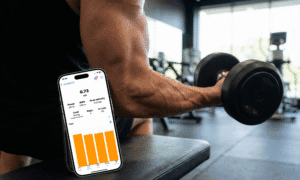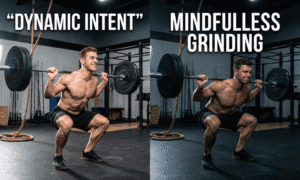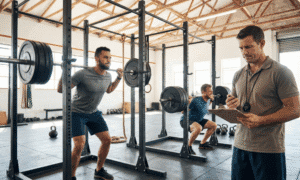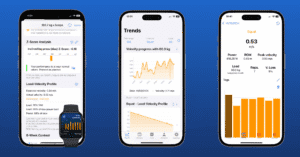Have you ever wanted to improve your performance in the gym more efficiently? Today we show you practically how we apply velocity based training in our training, thanks to Spleeft App and the new analysis features that we will gradually introduce in our app for the gym.
DOWNLOAD SPLEEFT APP NOW FOR iOS, ANDROID AND APPLE WATCH!

After a brief warm-up of about 15 minutes with a stationary bike and some mobility exercises, I started the workout by testing how my legs were doing 5 countermovement jumps (CMJ). This exercise is used in many sports to monitor daily fatigue in a quick way.
As you can see in the picture, I matched my record of 55 cm jump height, so I was ready to continue my training as planned.
After a brief warm-up of about 15 minutes with a stationary bike and some mobility exercises, I started the workout by testing how my legs were doing 5 countermovement jumps (CMJ). This exercise is used in many sports to monitor daily fatigue in a quick way.
As you can see in the picture, I matched my record of 55 cm jump height, so I was ready to continue my training as planned.

The first exercise was the inclined leg press. Until a few sessions ago, I used to perform this exercise last in the session. Since the last training session, I am performing it first, as I want to focus on improving strength at high loads (what is colloquially referred to as maximal strength). The previous session I tried lifting 215 kg. It went so well that my old power profile was obsolete. So today it was time to update it.
I have to lift at least three different loads, so I start “warming up” with 175 kg. I feel good and decide to go all at once to 235 kg, to freshly lift the heaviest load. Since I have a good lift in the database from the previous session with 215 kg, I trust the automatic load – velocity profile function to put both sessions together to give me my updated profile.
After the lift with 235 kg, I check the load – velocity profile and, indeed, with the data from this session together with the previous one Spleeft can automatically make my profile for this exercise. With the updated load-velocity profile, I also used the Workout PR feature to benchmark my performance, tracking my personal bests over time and making each session a clear step forward.
What is very striking is the increase in the metrics of this exercise (as can be seen with the maximum power load in the image) just by performing it first in the session. This cannot be a full performance improvement, as there is no such increase in any other exercise. How important it is to look at all the parameters that condition the load when evaluating and monitoring progress.
After the incline press it was time for the squat jump (SJ). I always like to perform this exercise first. As you can see in the picture, even though I broke my record in the CMJ, I’m already tired after the incline press test.
Since the goal of this exercise is to work on the velocity zone and my ability to apply force in short periods of time, I decide to lower the load to 20 kg to maintain the velocity of other days.
Between each set of SJ I am allowing at least three minutes of rest, to see if I am recovering from the fatigue of the test. Besides, I can’t improve velocity if I’m tired.
By the way, to measure jump height and associated metrics I am taking advantage of my Apple Watch 8 which allows me to measure at 200 Hz and thus the reliability of the data.
For the rest of the exercises (press, squat…) I am using the measurement at 100 Hz, since in internal studies we have seen that at intermediate velocities it is almost as accurate as at 200 Hz and thus the feedback is faster.

By the way, to measure jump height and associated metrics I am taking advantage of my Apple Watch 8 which allows me to measure at 200 Hz and thus the reliability of the data.
For the rest of the exercises (press, squat…) I am using the measurement at 100 Hz, since in internal studies we have seen that at intermediate velocities it is almost as accurate as at 200 Hz and thus the feedback is faster.


To finish with the SJ, I can usually jump 10 times without losing more than 10% jump height. As you can see in the picture, I had already slowed down significantly since the third time. It was on the seventh where the height loss warning and my own sensations indicated that I had to stop.
To finish with the SJ, I can usually jump 10 times without losing more than 10% jump height. As you can see in the picture, I had already slowed down significantly since the third time. It was on the seventh where the height loss warning and my own sensations indicated that I had to stop.

I move on to the one-legged squat. The day before I already had bad feelings with this exercise, it was where I began to accuse the fatigue of having tried with 215 kg the press. Today it seemed that it was going to be the same or even worse after the squat jump.
However, as you can see in the picture, it seems that with the right leg I have managed to recover a little and I can continue with the 40 kg with which I usually train.

I move on to the one-legged squat. The day before I already had bad feelings with this exercise, it was where I began to accuse the fatigue of having tried with 215 kg the press. Today it seemed that it was going to be the same or even worse after the squat jump.
However, as you can see in the picture, it seems that with the right leg I have managed to recover a little and I can continue with the 40 kg with which I usually train.

Finally, let’s go to the squat. I recently updated my load – velocity profile, so I check what load is associated with my maximum power, which is the goal of this exercise. Using the Calc 1RM feature, I quickly checked what my one-rep max could be for the squat, helping me adjust my strategy for future sessions to continue training efficiently.
I remember that it is 80 kg, a load with which I usually train, but when I did the press the last exercise. However, as I am encouraged after the one-sided squat I decide to try at least one set with this load to see how it goes.
The squat didn’t go bad at all, with a velocity very similar to other days. So, even though the perceived effort has been higher, as you can see in the record’s screenshot I share from Spleeft, I decide to continue with this load.
It is true that, in order to complete a decent number of repetitions, I performed the series in clusters, leaving intentional rests of at least 3 seconds.
I always leave breaks between repetitions, especially in exercises with jumping.
I finish my workout by performing a set of Romanian deadlifts. I am not measuring the velocity of this exercise lately. Likewise, I perform it for complementary purposes, to improve grip strength for braking with the bike and to work the core. Furthermore, I do not apply maximum intentionality, so there is no point, for the moment, to record the velocity.
Many of the screenshots we have shown you are complementary analysis functions that are not yet available, as of the date of publication of this article. However, you can comment on this blog or through our social networks with suggestions on these metrics or additional functionalities.
Iván de Lucas Rogero
MSC Physical Performance & CEO SpleeftApp
Dedicated to improving athletic performance and cycling training, combining science and technology to drive results.





